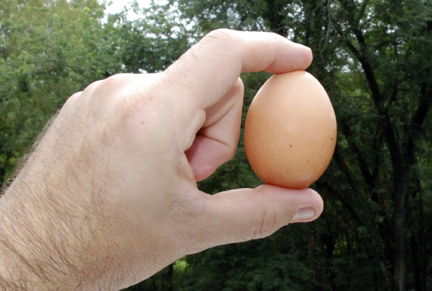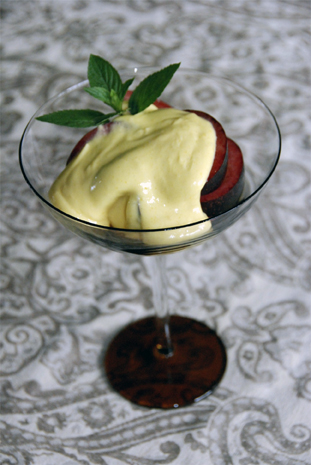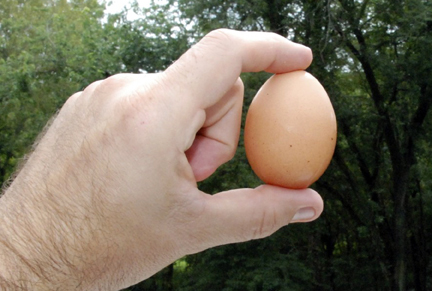 Consider the egg. Photo: Kurt Michael Friese
Consider the egg. Photo: Kurt Michael Friese
UPDATE: The owner of the hatchery in the video mentioned below has spoken out, says there were violations of procedure but makes no apologies. He calls “instantaneous Euthanasia” “Standard industry practice.” Read the story here.
Iowa is the number-one producer of eggs in the country, with more than twice the number of laying hens than Ohio, the number two state. There are nearly 20 times as many hens here than there are people, producing a shade over 14 billion eggs a year. As one might expect, their living conditions are less than ideal.
A cursory glance at the website of the Iowa Egg Council does not reveal any of the images of the way the laying hens are treated, but rather concerns itself with recipes, coloring books for the kids, and “Eggbert’s” somewhat rosy history of egg production in Iowa. A search of their site for the term “battery cage” yields a goose egg. But battery cages are one of the major reasons why Iowa out-produces everyone else – we have lots of them.
Across the US there are about 280 million hens in battery cages at any given time, cages that so severely restrict their movements that they cannot even spread their wings. They can’t nest, bathe in the dust, perch or forage, all instinctive chicken behaviors. Completely depleted of calcium in a few short weeks, their bones break and they are shipped off, dead and dying, to soup plants and pet food factories.
Then of course there’s the small issue of the effluent these factories produce, which must be stored lest it leak into the environment, which inevitably it does. The fumes threaten the health not only of the workers at these facilities but of the neighbors on the surrounding farms too.
While it’s true that none of this is news, it is interesting to note the ways people have opted out of participating in this heinous activity, and the ways that Big Egg has attempted to mask their misdeeds.
Here in Iowa City two years ago the student body of the University of Iowa voted to ban those eggs, insisting that only “cage-free” eggs be served to the 31,000 students and 15,000 staff members who live, work and learn in the Old Capitol. Sadly though, taking them out of the cages does not usually lead to bucolic lives on Old MacDonald’s farm.
Cage-free eggs come from chickens raised in warehouses in their thousands, beaks mutilated to prevent them from pecking each other to death due to stress, and exposed to ammonia and hydrogen sulfide gasses. Of course these are all hens. The male chicks were ground up alive soon after hatching and made into feed or fertilizer. They don’t lay eggs and are therefore of no use to the industry.
Yet all of this is only part of the reason why I don’t use such eggs in my restaurant. Our eggs come from Steve Rogers of Highland Vista farms, who runs his operation based on the model of sustainable-farm folk hero Joel Salatin. His chickens live on pasture, with the freedom to come and go from the coop as they please. They’re locked up at night to protect them from predators, and the rest of the time they scratch and forage on a different patch of pasture as they are moved about the farm. They live very happy, natural chicken lives and you can taste it in the eggs.
They cost us about three times what the factory eggs cost, or about $54.00 for a case of 15 dozen, which breaks down to about 30 cents an egg. Pricey? Perhaps, but it means 60 cents worth of the plate cost of the huevos rancheros we serve at brunch every Sunday, and when it comes to freshness and flavor (not to mention nutritional quality) there is simply no comparison.
We occasionally serve a very simple egg-based dessert over seasonal fresh fruits called Zabaglione (the French call it Sabayon). It always wins raves for it’s rich decadence. But each time a customer asks if we add turmeric or saffron to make it so yellow, I smile and say “no, that’s what eggs are supposed to look like.”
 A little zab’ll do ya’.Photo: Kurt Michael FrieseZabaglione
A little zab’ll do ya’.Photo: Kurt Michael FrieseZabaglione
6 egg yolks
2/3 cups sugar
2/3 cups Marsala wine (or substitute rum, or Grand Marnier, or whatever turns you on)
Place a stainless steel bowl over a simmering saucepan of water to create a double boiler. In the bowl, whisk the eggs briskly and constantly with the sugar. While continuing to whisk, drizzle in the Marsala wine. Continue to whisk until the mixture becomes light and fluffy, a lttle like whipped cream at soft peaks.
Serve immediately over your favorite fresh fruits. Serves 4-6



